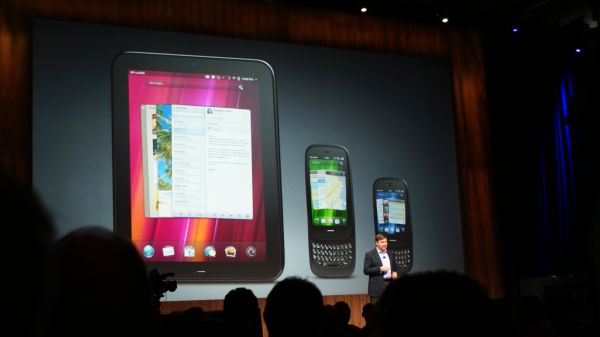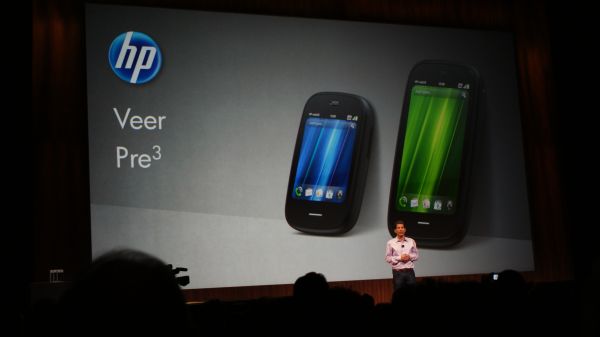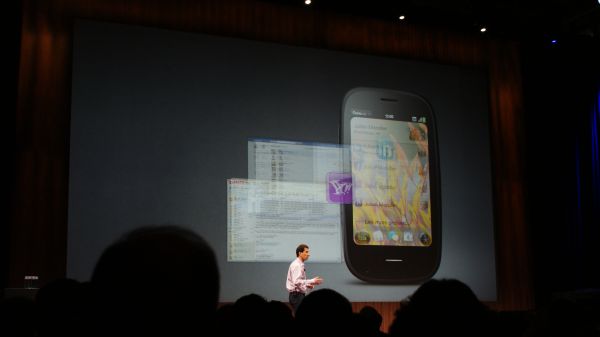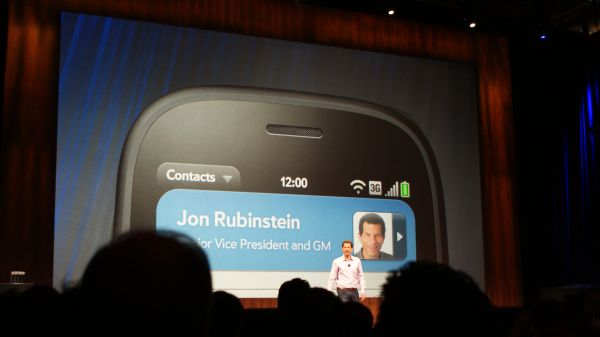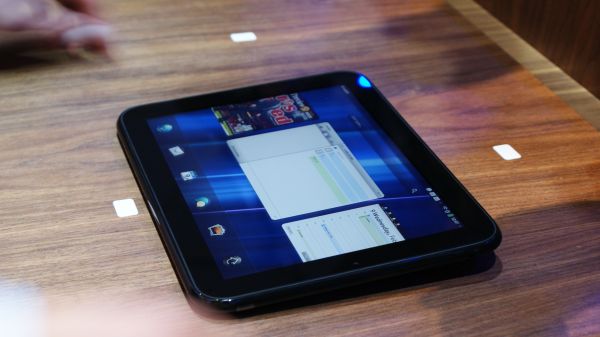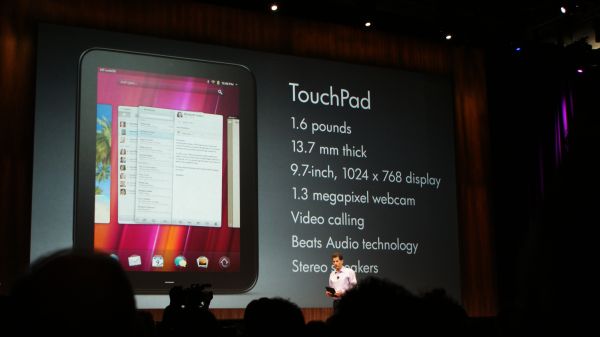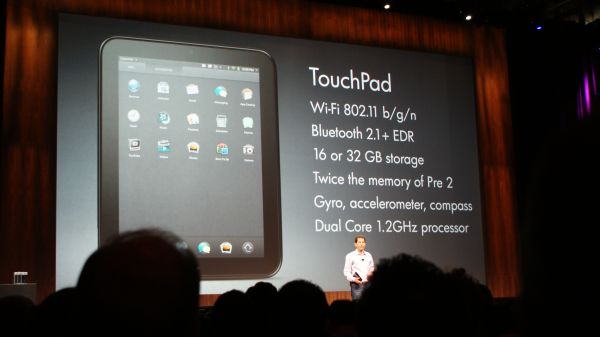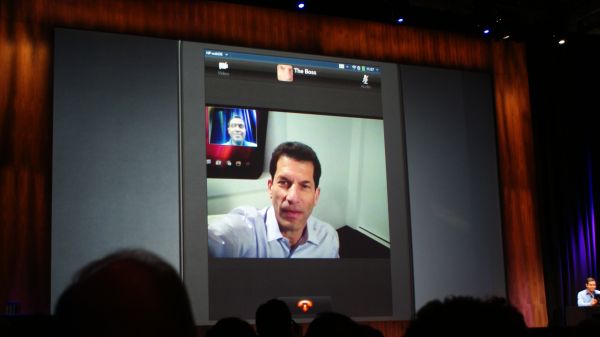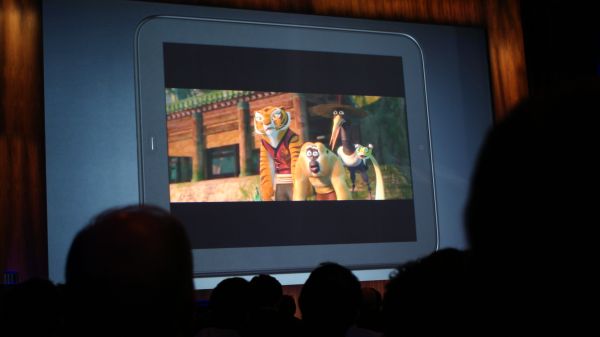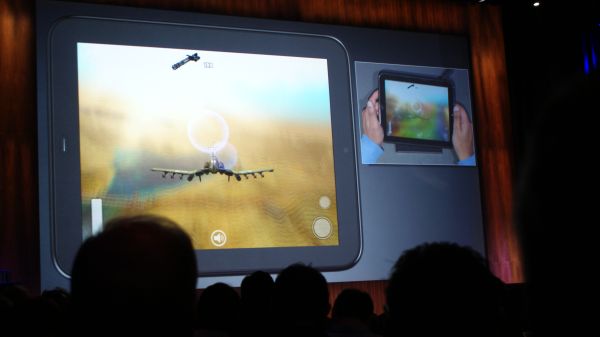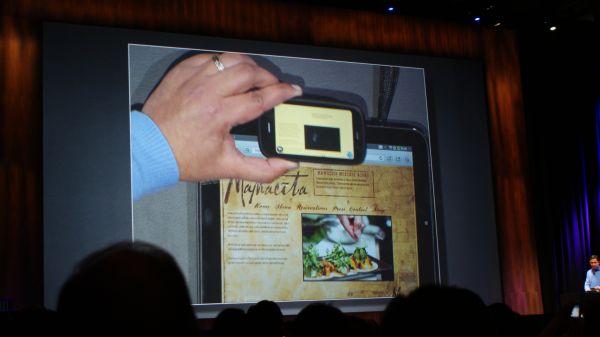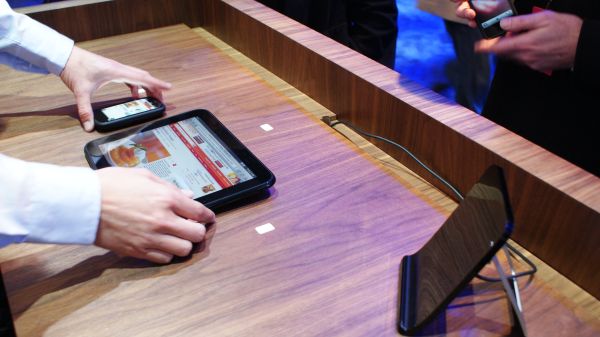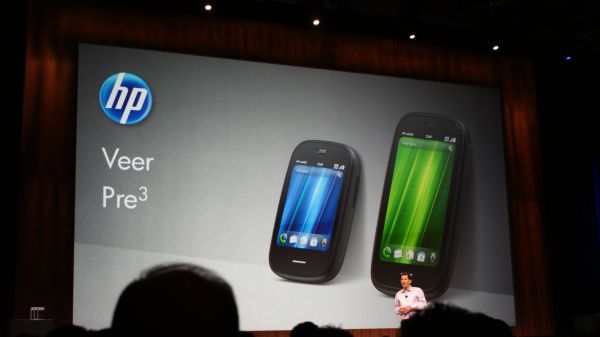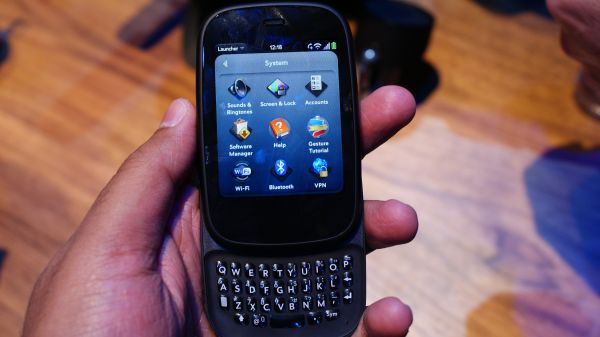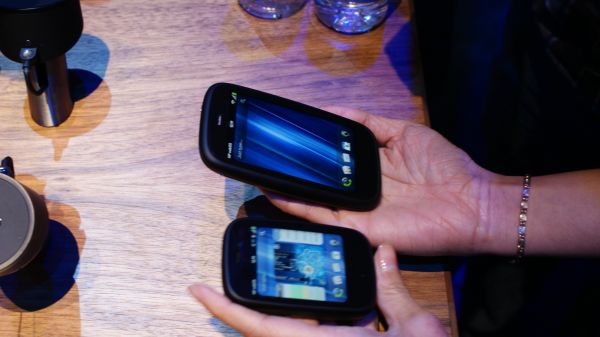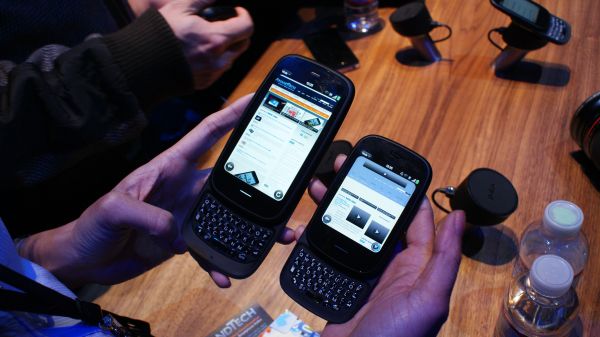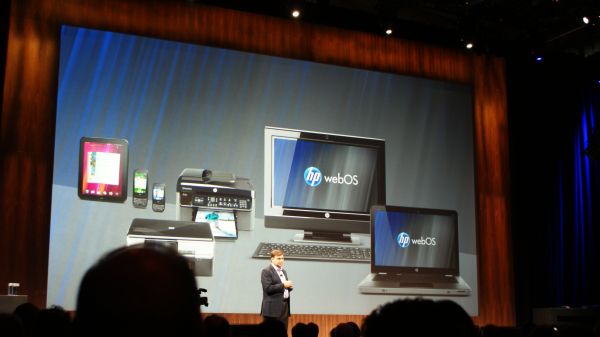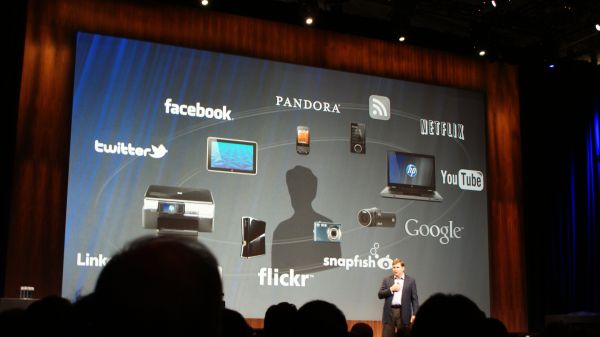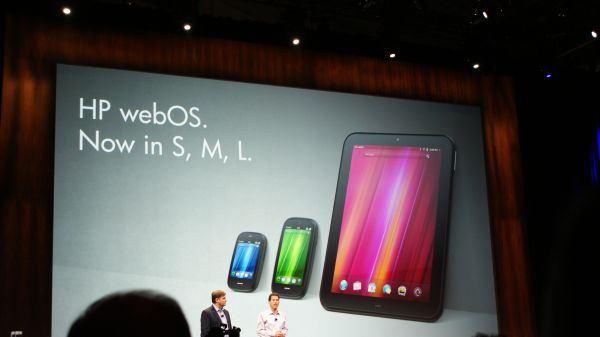
Original Link: https://www.anandtech.com/show/4161/analysis-of-hps-event-its-raining-webos
Analysis of HP's event : It's Raining webOS
by Mithun Chandrasekhar on February 9, 2011 9:49 PM ESTToday's HP webOS event was all about letting everyone know that webOS is definitely here to stay and HP is putting in massive resources (human and monetary) to ensure that webOS puts up a decent fight. To this effect, three product announcements were made today; the TouchPad tablet, the Pre 3 smartphone targeted at professionals and the Veer, which is unlike anything out there today (except maybe the Sony Ericsson Xperia X10 Mini).
Information about what HP may be announcing today has been leaking out through various sources in the days leading to today's event. That a tablet and a successor to the Pre 2 would be launched today was a given. But seeing the devices and the whole webOS eco-system actually work together (and very well) was definitely a pleasant surprise. Plus the Veer announcement out of the blue was an added bonus, and a good one at that.
We'll first be talking about the device that was clearly the star of the show, the TouchPad. We will then look at the Pre 3 and Veer smartphones and wrap it up with other interesting announcements that were made today.
Clearly the one single item that HP focused on (and also wanted us to) was the HP TouchPad tablet. This marks HP/webOS' entry into what is going to be one of the most competitive sectors of 2011, the tablets. Based on my initial impressions and assuming HP makes good use of the time they have till they launch the device in summer, the TouchPad is possibly one of the strongest entrants. Let's get down to the details.
TouchPad is actually going to be a family of webOS tablet devices. Although no other tablet devices were specifically announced, HP did confirm that variations of the current TouchPad (with 3G/4G) and other additions to the TouchPad family will launch sometime in the future. So although the current TouchPad itself is positioned squarely at the Apple iPad, there is no ruling out the possibility that smaller (and possibly larger) tablets will also face some heat from webOS powered devices.
The TouchPad announced today actually runs webOS version 3.0. However, HP did not disclose any further details about 3.0 or what features presented today would be 3.0-only. The focus was the TouchPad itself, which is powered by the Qualcomm Snapdragon 8x60 SoC which consists of a dual-core Scorpion processor humming along at 1.2Ghz. The TouchPad is the first device to make use of Qualcomm's new 8x60 series of Snapdragon SoC's. You can find more details about this SoC on this page but to summarize, this is a 45nm SoC with dual-cores running at 1.2GHz , sharing 512KB of L2 cache and has the new Adreno 220 GPU. The rated power at maximum load for this SoC is about 1.2W and its memory interface supports LP DDR2. As such, the TouchPad comes with 1GB (double that of the Pre 2, and 4 times as much as the iPad) worth of RAM.
What is not clear though is although the TouchPad announced today was WiFi-only, since the SoC does support a cellular baseband (HSPA and/or EV-DO depending on the particular SoC version), will HP expose this functionality via a firmware upgrade (assuming antennas are built-in) or will they release a new SKU with cellular functionality? Either way, the TouchPad will be available in 16GB and 32GB versions and all versions sport 802.11 b/g/n and Bluetooth 2.1+ radios along with a gyroscope, accelerometer and compass. All of this will be packed into a chassis about 13.7mm thick and weighing 1.6 pounds.
Update: Qualcomm has confirmed today that the Snapdragon in the TouchPad is an applications-only SoC without baseband support. Dubbed the APQ8060 (instead of the MSM/QSD prefix for its baseband-equipped SoC's), this gives a much clearer understanding of why the current TouchPad is and will be WiFi only.
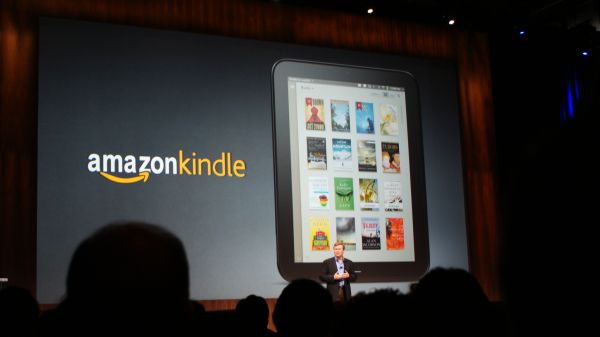
(Left) Amazon Kindle app announcement, (Right) Video chat demo
Now, for features of the TouchPad that are visible, it sports a 9.7-inch 1024x768 display (matching the iPad and being bested by the Xoom in terms of pixel density), although it is not clear whether the TouchPad uses an IPS panel. Atop the display is a 1.3MP front-facing camera that can be used for video calls. Unfortunately the TouchPad does not have a rear-facing camera. The TouchPad also houses stereo speakers (with Beats Audio technology...something that was heavily pushed today). Without actually using the device it is difficult to quantify the quality of any of the above, but from the in-person demos, the screen does have pretty good vieweing angles.
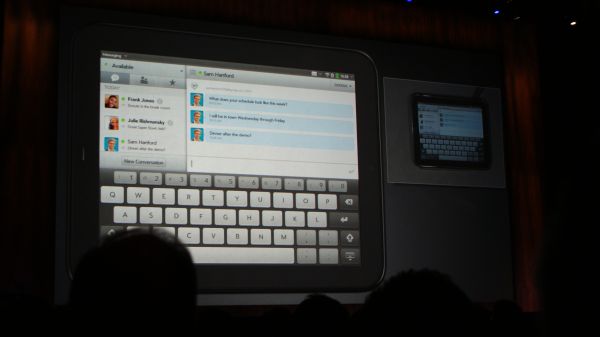
(Top left) Flash HD demo, (Top Right) Armageddon Squadron 2
(Bottom left) Resizeable on-screen keyboard, (Bottom right) Touch-to-Share feature demo
Unlike the Pre 3 that was tagged as a 'professional' device, HP did demo non-professional use cases on the TouchPad by playing an HD Flash video (Kung-Fu Panda), an OpenGL game (Armageddon Squadron 2) and a bunch of Time magazine applications which looked quite impressive. The Flash video played perfectly fine with no skipping or stuttering of any sort. In addition, the game demo was impressive in terms of both the fidelity and performance. It was certainly more impressive than the demos we saw on the Motorola Xoom at the Android 3.0 event.
HP also demonstrated how the TouchPad plays very well with the Pre 3 via the Touch-to-Share feature. Pair the 2 devices via a single button press and from then on, simply 'tap' the Pre 3 onto the TouchPad and the content you were browsing on the tablet now gets transferred to your phone. As shown in the demo, if you were browsing a particular website or reading a particular email on the tablet and you have to rush out without the tablet, just tap the Pre 3 onto the TouchPad and the exact same content is now displayed on the phone. Although I can think of an iOS app that does something along these lines, the functionality and integration shown here is much more straightforward and useful.
And integration is exactly what HP is pushing for with the TouchPad, across the webOS eco-system. Touch-to-Share, wireless printing to almost any HP wireless network printer, deep integration with webservices, all point to how webOS thrives off of connectivity. HP also showed off the improvements made to the email client (multi-select delete...finally!) and how messages received on your Pre 3 can be read and replied-to from the TouchPad.
Given how all the demos on the TouchPad involved working efficiently with multiple apps running in the background, the fact that it is powered by a dual-core CPU should lend itself to such use-cases very well. Since the TouchPad was in fact running a different version of webOS, it is clear that multiple thread scheduling and dispatch capabilities are built into webOS; it's just that HP doesn't feel it is required outside the tablet-space right now (which may also explain why the Veer/Pre 3 have single-core CPUs).
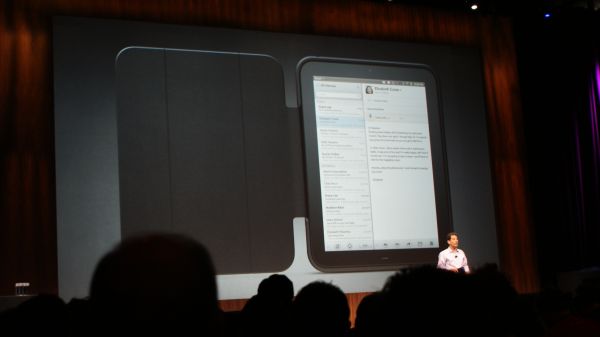
(Left) a case that doubles as a stand (Right) and a stand that doubles as a charger.
Finally, HP announced that they have collaborated with Amazon and Skype to bring both the Kindle reader and Skype apps to the TouchPad. In addition, they also anounced a bunch of accessories for the TouchPad, including a slick-looking Touchstone charger that doubles as a stand.
As mentioned earlier, because of various leaks leading to the event, we knew a tablet and a successor to the Pre 2 were launching today. But what came as a complete surprise was the dimunitive QWERTY-slider, Veer.
As Jon Rubenstein demonstrated while announcing the Veer, the phone is no bigger than a standard credit-card. While the small body may lead you to believe that the same downsizing trend follows through to the internals, it was a pleasant surprise when we saw that it is actually powered by the Qualcomm MSM7230 SoC consisting of a Scorpion core running at 800MHz and an Adreno 205 GPU. This is the same SoC that powers the T-Mobile G2 whose performance has been previewed here. As can be seen in those graphs, the 7230 is no slouch. Further, this is an HSPA-only chipset and as a result will only be available on AT&T or T-Mobile (assuming a carrier does pick it up here in the US).
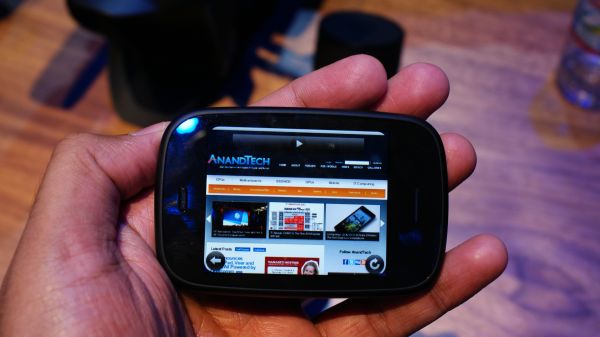
The HP Veer is about the size of a credit-card with the slider closed
Apart from packing in a decent SoC, the Veer has 512MB of RAM and 8GB of storage onboard. The Adreno 205 GPU drives a rather small 2.6" 320x400 screen. While definitely losing out on the real estate side of things, the screen is very sharp and during use I didn't really find it bothersome. However, surfing the web will definitely prove to be an issue. Speaking of web, the Veer supports Adobe Flash as well. It also comes equipped with a 5MP camera, 802.11 b/g, and built-in GPS. The Veer should be the first of the new webOS devices to hit the market with a projected launch happening sometime towards the end of this Spring.
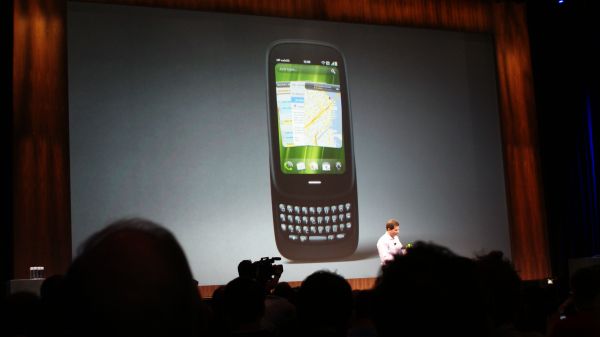
(Left) The HP Pre 3, (Right) the Pre 3 looks gigantic compared to the Veer
Moving on, we have the last device announcement, the HP Pre 3. This is probably the device that we know the least about because HP didn't talk a whole lot about it and we weren't allowed to use the demo devices ourselves. It's the Pre 3's internals that piques our interest the most. What powers this smartphone is a Qualcomm 8x55 SoC that has a single Scorpion core rated for 1GHz. However in the Pre 3, the core runs at 1.4GHz. This is a 40% increase over the rated clockspeed for this particular 45nm SoC and aside from the unreleased 8x7x series, it's the highest clocked Qualcomm core.
The rated power at load with the core running at 1GHz is 500mW, so it will be interesting to see how the battery life will play out on the Pre 3 considering the fact that we should theoretically be hitting close to 700mW at full throttle (for reference, the Pre 3's 1230 mAh battery is just 7% larger than the one found in the Pre Plus). The 8x55 core also sports an Adreno 205 core driving a 3.6" 480x800 display, along with support for LP DDR2 RAM (the Pre 3 has 512MB). Also, while HP just stated the SoC family while referring to the '8x55', since they do brand it as being a world phone capable of both HSPA+ and EVDO Rev.A basebands, it is clear that they are using the QSD8655 in the Pre 3. Why they didn't specify this in the presentation, I'm not sure.
The Pre 3 will be available in 8GB or 16GB versions, sporting 802.11 b/g/n and Bluetooth 2.1+ radios along with GPS. The rear-facing camera on the Pre 3 is a 5MP unit, although this time with autofocus and LED flash assist. The Pre 3 is also capable of recording 720p HD video. It features a front-facing VGA camera to be used for video calls. This slide-out QWERTY packing phone is expected to be launched sometime this summer.
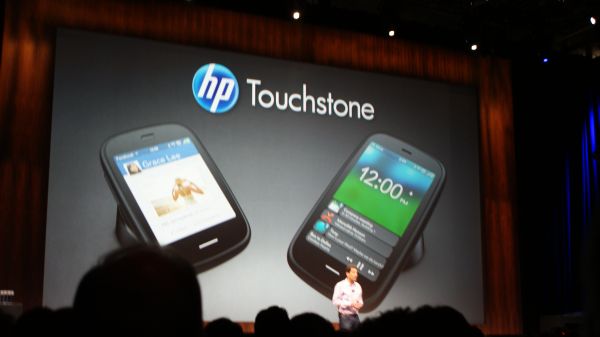
(Left) Both phones support Touchstone charging, (Right) in a quick browser speed test (history cleared), the Pre 3 was notably faster than the Veer by a good 5 secs
Both the phones will support Touchstone inductive-charging functionality and both have 'gesture areas' below their LCD's (unlike the touchscreen-only TouchPad). As mentioned on the previous page, it seems clear that HP is looking at high-frequency cores to make up for webOS 2.x's apparent inability to efficiently schedule multiple threads. It remains to be seen if this approach affects real-world usage in the smartphone form-factor.
While the device announcements were easily the big ones today (with the TouchPad being the biggest), HP did drop a lot of hints on how it plans on steering webOS onto more than just smartphones and tablets.
Although HP's Todd Bradley didn't go too deep into it, he did mention that HP was definitely going to bring webOS to 'other new form factors', including printers and PCs. Yep, you heard that right. HP is planning on porting over webOS to its PCs sometime in the future.
Now this announcement has multiple interesting implications. For one, this will give Intel the opportunity to have its x86 CPUs power webOS, and that in itself could lead to some interesting prospects in the tablet/netbook arena. Secondly, considering the number of PCs, laptops, and netbooks HP sells world wide, having webOS run natively (or virtualized) on those machines would definitely help build up a vast userbase of webOS 'devices'. And considering the fact that user install base is probably one of the biggest factors that decides how much developers would want to invest their resources in supporting a platform, HP would do itself and webOS very good by opening up this huge potential install-base to the devs. And finally, I can only imagine the prospects of technologies such as 'Touch-to-share' if it were to roll-out on to PCs as well.
Hopefully, if HP were to continue onward with the same momentum they demonstrated today, what is listed above may actually happen a lot quicker than we can imagine.
Apart from this, on a slightly more down-to-earth note, HP announced that the Pre 2 will be available for preorder on Verizon starting February 10. Whether today's announcements will help or hurt the Pre 2's prospects remains to be seen. A number of HP's partners took to stage, including the CEOs of Beats Audio, Time, DreamWorks, etc., but the one that stood out was Dr. Paul Jacobs. He is the CEO of Qualcomm and he talked about the close partnership between HP and Qualcomm during the development of the new webOS devices. While we don't know the technicality behind the Pre 3's increased clockspeed as of yet, what we do know is that Qualcomm is definitely wooing HP to have Snapdragon power its devices, especially since Google has gone with NVIDIA and its Tegra 2 architecture as a reference platform for Android 3.0.
Update: I forgot to add this while uploading the article at midnight, but it does look like the 'Palm' brand is buried, at least for the end-user. Although no official announcement was made to this effect, there was absolutely no Palm branding listed anywhere on the slides, devices, or even the updated website.
Final Thoughts
To sum it up, it was a very strong showing on HP's part today. They didn't waste much time getting the point across: HP thinks webOS is big, and I will agree with them on most counts here. In my own personal opinion, webOS is probably one of the best mobile platforms currently available. While device build-quality, performance, developer support, poor marketing, and a lot of other factors may have led to webOS' rather lacklusture uptake, the OS in itself and the paradigm driving it is pretty solid and the user interface is probably one of the best. What will decide its future will be the execution.
On paper, HP has put forth some good devices and a whole lot of mouthwatering prospects. If done correctly, HP could have a self-contained ecosystem of webOS devices, transcending form-factors and use-cases. It remains to be seen how all of this is put into practice.

